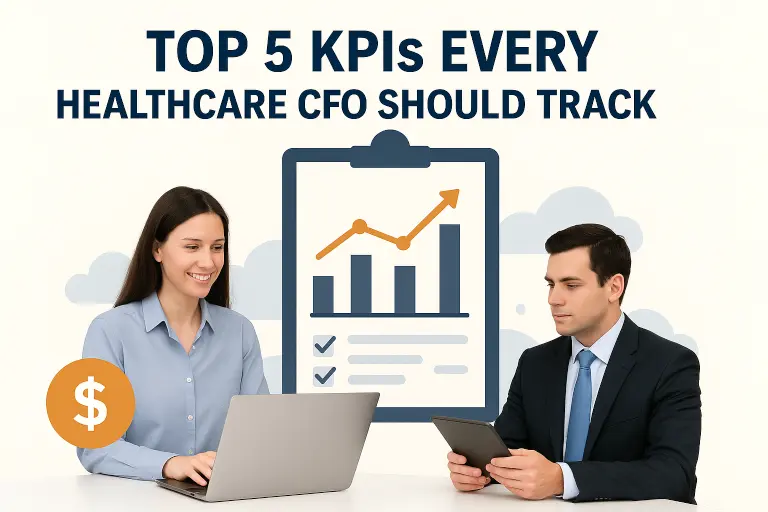Introduction: Financial Clarity in a Complex Environment
Healthcare CFOs face one of the most intricate financial ecosystems in any industry—where clinical operations, payer contracts, and patient engagement all converge into one outcome: cash flow. Amid rising payer denials, labor costs, and shifting reimbursement models, financial leaders need visibility into the right performance metrics. Tracking a handful of high-impact revenue cycle KPIs enables CFOs to anticipate risk, allocate resources efficiently, and drive sustainable profitability.
These five key performance indicators (KPIs) are foundational for every healthcare CFO aiming to improve operational control and long-term revenue health.
1. Clean-Claim Rate (CCR)
Why it matters:
The clean-claim rate reflects the percentage of claims accepted and paid upon first submission. It’s the ultimate early indicator of process efficiency.
Best-in-class performance: ≥ 98 %
Industry average: 90–94 %
CFO insight:
Each percentage point drop below benchmark translates to delayed cash and increased rework cost. CFOs should monitor clean-claim rate alongside denial rate and DSO for a full cash-flow picture. High-performing organizations leverage analytics to identify recurring data-entry errors, coding issues, or payer-specific rejection trends and assign accountability at the departmental level.
2. Days in Accounts Receivable (DSO)
Why it matters:
DSO measures how long it takes, on average, to collect payment after a service is rendered. The lower the DSO, the faster your organization turns revenue into usable cash.
Best-in-class performance: ~30 days
Industry average: 45–55 days
CFO insight:
Extended DSO often signals front-end inefficiencies—missing pre-authorizations, incomplete documentation, or billing edits not addressed promptly. CFOs should segment DSO by payer and location to identify bottlenecks. Pairing this metric with denial and collection data provides a precise view of payer performance and cash-flow risk.
3. Net Collection Rate (NCR)
Why it matters:
Net collection rate reflects the percentage of collectible revenue actually collected after contractual adjustments. It’s a true measure of effectiveness in converting available dollars into cash.
Best-in-class performance: ≥ 98 %
Industry average: 94–96 %
CFO insight:
A declining NCR may indicate underpayment issues, contractual mismanagement, or uncollected self-pay balances. CFOs should analyze NCR by payer class and service line to find margin erosion points. Integrating contract analytics tools can uncover payer underpayments or rate discrepancies automatically.
4. Denial Rate
Why it matters:
Denials represent both revenue leakage and wasted labor. A high denial rate not only delays reimbursement but also drives up the cost to collect.
Best-in-class performance: ≤ 4 %
Industry average: 7–10 %
CFO insight:
Executives should segment denials by root cause—front-end registration, coding, or payer issues. Predictive analytics can now forecast denial probability before submission, allowing proactive correction. Tying denial reduction goals to department KPIs and quarterly scorecards creates organization-wide accountability.
5. Self-Pay and Patient Collections
Why it matters:
With patient responsibility accounting for 15–30 % of revenue in many organizations, self-pay collections are becoming a major determinant of financial stability.
Best-in-class performance: ≥ 90 % recovery
Industry average: 70–80 % recovery
CFO insight:
Improving patient collections isn’t just about better billing—it’s about engagement. Offering transparent estimates, digital payment options, and early financial counseling significantly improves recovery. Analytics can segment patients by balance size and payment propensity, ensuring focused outreach and higher yields.
Aligning KPIs to Financial Strategy
The key for CFOs is to move beyond static reporting. Metrics must integrate into a continuous performance management framework, where trends trigger root-cause reviews and corrective action. Leading CFOs build monthly RCM performance dashboards featuring:
- KPI heat maps (green/yellow/red)
- Month-over-month and payer-level variance
- Drill-down capabilities by facility or specialty
This approach turns financial oversight into a proactive management tool—bridging finance, operations, and clinical teams around shared accountability.
Technology and Analytics as Force Multipliers
AI-driven dashboards and revenue intelligence platforms now consolidate these KPIs into real-time insights. Instead of waiting for month-end close, CFOs can monitor daily shifts in clean-claim rate, DSO, or denial trends.
For example:
- Predictive modeling can flag payers trending toward higher denial risk.
- Machine learning can identify outliers in charge capture.
- Data visualization makes it easier for executives to correlate operational inefficiencies with cash impact.
By leveraging technology, CFOs transform data into strategic decision-making power.
Benchmarking and Governance
Establishing clear benchmarks for each KPI is only the first step. Governance is what sustains improvement. Set thresholds and escalation triggers—if denial rate exceeds 4 % or DSO rises above 35 days, leadership reviews root causes within 48 hours. Integrate KPI adherence into executive scorecards, ensuring accountability across revenue cycle, clinical, and administrative teams.
Conclusion: From Data to Action
The most successful healthcare CFOs don’t just track KPIs—they lead through them. By focusing on the five key indicators—clean-claim rate, DSO, net collection rate, denial rate, and patient collections—executives can align financial performance with operational excellence. These metrics form the backbone of a data-driven revenue cycle strategy—delivering not only better financial outcomes but also greater confidence in navigating a complex, value-based healthcare landscape.





